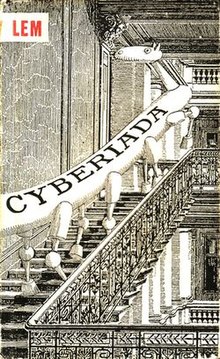The Cyberiad

First Edition (Polish)
|
|
| Author | Stanisław Lem |
|---|---|
| Original title | Cyberiada |
| Translator | Michael Kandel |
| Illustrator | Daniel Mróz |
| Country | Poland |
| Language | Polish |
| Genre | Science Fiction |
| Publisher |
Wydawnictwo Literackie (Polish) Harcourt Brace (English) |
|
Publication date
|
1965 |
|
Published in English
|
1974 |
| Media type | Print (Paperback) |
| Pages | 295 pages |
| ISBN | |
| OCLC | 11398261 |
| 891.8/537 19 | |
| LC Class | PG7158.L39 C813 1985 |
The Cyberiad (Polish: Cyberiada) is a series of humorous science fiction short stories by Stanisław Lem. The Polish version was first published in 1965, with an English translation appearing in 1974. The main protagonists of the series are Trurl and Klapaucius, the "constructors".
The vast majority of characters are either robots or intelligent machines. The stories focus on problems of the individual and society, as well as on the vain search for human happiness through technological means. Two of these stories were included in the book The Mind's I.
The whole series was published in the 1965 Polish collection Cyberiada by Wydawnictwo Literackie and also included stories published previously elsewhere.
Polish title: Siedem wypraw Trurla i Klapaucjusza All these stories were first published in the 1965 Polish collection Cyberiada by Wydawnictwo Literackie.
Trurl and Klapaucius are brilliant (robotic) engineers, called "constructors" (because they can construct practically anything at will), capable of almost God-like exploits. For instance, on one occasion Trurl creates an entity capable of extracting accurate information from the random motion of gas particles, which he calls a "Demon of the Second Kind". He describes the "Demon of the First Kind" as a Maxwell's demon. On another, the two constructors re-arrange stars near their home planet in order to advertise.
The duo are best friends and rivals. When they are not busy constructing revolutionary mechanisms at home, they travel the universe, aiding those in need. As the characters are firmly established as good and righteous, they take no shame in accepting handsome rewards for their services. If rewards were promised and not delivered, the constructors may even severely punish those who deceived them.
The universe of The Cyberiad is pseudo-Medieval. There are kingdoms, knights, princesses, and even dragons in abundance. Robots are usually anthropomorphic, to the point of being divided into sexes. Love and marriage are possible. Physical and mental disabilities, old age and death, particularly in case of accidents or murder, are also common, though mechanical language is used to describe them. Death is theoretically avoidable (by means of repair), and sometimes even reversible.
...
Wikipedia
